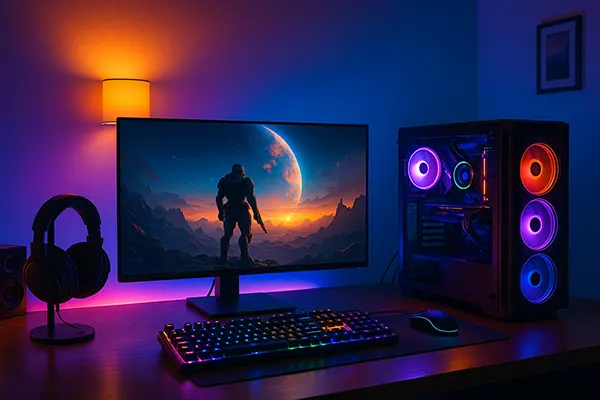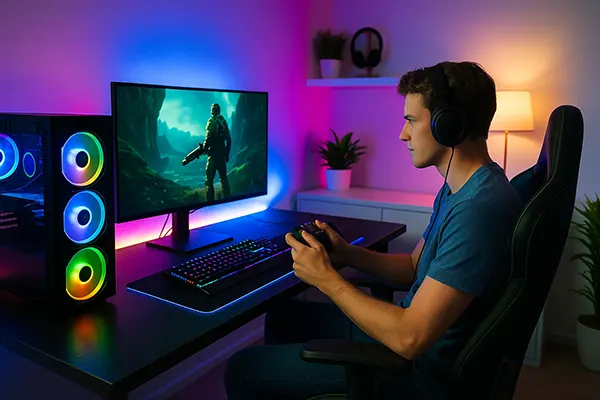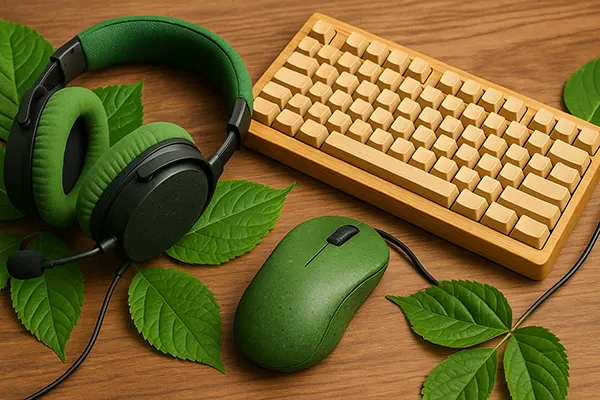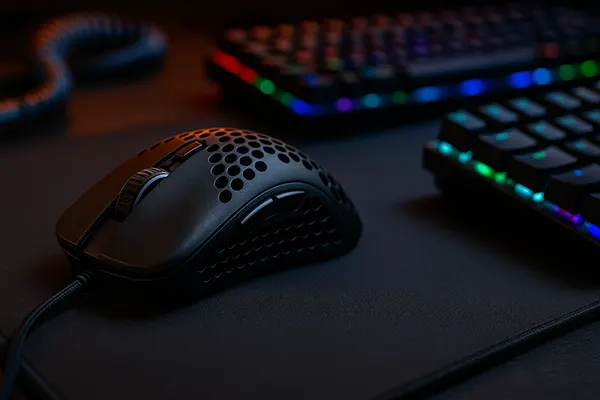
Adaptive Lighting in Gaming Spaces: RGB Illumination, White Light, and Its Impact on Performance and Mood
Lighting has evolved from a mere decorative element to a critical factor in gaming performance and comfort. In 2025, adaptive lighting technologies allow players to personalise their spaces not only for aesthetics but also to support visual focus, reduce fatigue, and enhance emotional engagement. Modern systems integrate seamlessly with peripherals and smart devices, transforming the gaming room into a responsive, immersive environment.
Types of Gaming Lighting: From RGB to Neutral White
Modern gaming environments utilise a combination of RGB lighting and white illumination to achieve both functionality and atmosphere. RGB lighting, with its millions of colour options, enables gamers to customise the ambience to match the game genre or personal preference. For example, cool tones promote alertness during competitive play, while warm tones encourage relaxation during longer sessions.
White light remains essential for clarity and balance. Adjustable white illumination—ranging from cold daylight to soft neutral—provides visibility for reading displays, managing gear, or streaming. High-quality LED systems, such as Philips Hue or Govee, offer the flexibility to switch between these modes instantly.
Indirect or diffused lighting also plays an important role. Rather than placing lights directly in view, gamers increasingly prefer soft backlighting behind monitors and furniture. This approach minimises glare and creates a more even distribution of light across the workspace, reducing eye strain during extended sessions.
Balancing Aesthetics and Functionality
Successful lighting setups balance aesthetic pleasure with practical benefits. While RGB effects can highlight a gaming identity, the placement and brightness settings should prioritise visibility and comfort. For instance, too intense lighting behind the screen may cause colour distortion, while insufficient brightness increases eye fatigue.
Using smart controllers or adaptive lighting apps, players can create profiles for different situations—competition, streaming, or rest. This ensures consistent comfort regardless of activity. Moreover, synchronisation with screen visuals or music creates a dynamic environment that enhances immersion without becoming distracting.
Designers increasingly recommend modular systems that can adapt to furniture or wall geometry. This flexibility allows players to expand or rearrange their setup without losing uniform light distribution. It also helps maintain the ideal balance between light temperature, contrast, and reflection angles.
How Lighting Influences Concentration and Performance
Scientific research confirms that lighting directly affects cognitive performance and visual perception. Cooler, bluish-white light enhances alertness and reaction times, making it ideal for esports competitions and fast-paced games. In contrast, warmer hues encourage relaxation and support decision-making during strategy-based sessions.
Brightness control is equally important. Overly bright lighting can wash out screen colours, while dim settings cause pupils to dilate, leading to faster fatigue. The optimal balance is achieved when the brightness of the environment complements the screen rather than competing with it.
Ambient lighting also reduces contrast stress between the monitor and surrounding darkness. Bias lighting—soft illumination behind or around the display—helps prevent visual fatigue by maintaining consistent field brightness. This is particularly beneficial for gamers who spend hours in front of large or curved screens.
Psychological and Emotional Effects
Lighting influences not only visual comfort but also emotional stability. Dynamic RGB systems can create an atmosphere of excitement or calm depending on the hue. For example, red lighting raises adrenaline levels, suitable for competitive gameplay, while blue or purple tones promote focus and serenity.
Smart lighting systems now incorporate circadian rhythm features that adjust colour temperature throughout the day. During daytime hours, they emit cooler tones to maintain energy, shifting to warmer tones in the evening to support relaxation and better sleep quality. This functionality bridges the gap between gaming performance and well-being.
In 2025, many gaming brands are exploring lighting as part of ergonomic design. Combining visual comfort with mental relaxation helps maintain healthy gaming habits. Users who optimise their environment in this way often report improved performance consistency and overall satisfaction.

Integration with Gaming Peripherals and Smart Systems
Modern lighting no longer functions independently—it interacts with keyboards, mice, and headsets through unified ecosystems such as Razer Chroma, Corsair iCUE, and ASUS Aura Sync. This allows the entire setup to react simultaneously to in-game actions or music rhythm, amplifying immersion.
Beyond entertainment, integration serves functional purposes. For example, lighting can provide notifications for low health in a game, signal messages, or display system temperature through colour shifts. This multi-sensory feedback enhances awareness without interrupting the experience.
Budget-friendly solutions are also becoming accessible. Mid-range smart LED strips and lamps from brands like Nanoleaf or Yeelight provide synchronisation options compatible with mainstream gaming gear. These products allow players to achieve professional-grade setups without investing in costly studio lighting.
Choosing the Right Setup for Your Space
Before purchasing, gamers should assess room dimensions, wall colours, and monitor placement. Matte walls reflect light evenly, while glossy surfaces can create glare that distracts from the game. Choosing the right light temperature and placement can significantly improve both aesthetics and performance.
Experts advise starting with a simple bias lighting kit behind the monitor, then gradually expanding with ceiling or wall-mounted fixtures. This approach ensures incremental improvement while maintaining control over the visual balance of the room.
Ultimately, the ideal lighting system combines technical precision with personal expression. Adaptive solutions that support both productivity and relaxation have become an integral part of a professional gaming environment, shaping not only performance but also overall well-being.



